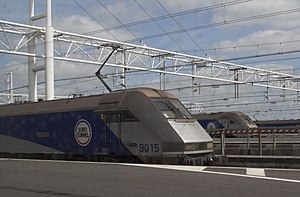Eurotunnel Class 9

Eurotunnel 9015 (2009)
|
|||||||||||||||||||||||||||||
|
|||||||||||||||||||||||||||||
|
|||||||||||||||||||||||||||||
|
|||||||||||||||||||||||||||||
|
|||||||||||||||||||||||||||||
| Type and origin | |
|---|---|
| Power type | Electric |
| Builder |
ASEA Brown Boveri Brush Traction (assembly) Qualter Hall (locomotive and bogie superstructure) |
| Build date | 1993–2002 |
| Total produced | 58 |
| Rebuilder | Brush Traction / Bombardier Transportation |
| Specifications | |
|---|---|
| Configuration: |
|
| • UIC | Bo-Bo-Bo |
| Gauge | 1,435 mm (4 ft 8 1⁄2 in) standard gauge |
| Wheel diameter | 1,250 mm (49.2 in) |
| Length | 22 m (72 ft 2 in) |
| Width | 9 ft 9 in (2.97 m) |
| Height: |
|
| • Pantograph | 13 ft 9 in (4.19 m) |
| Loco weight | 132 tonnes (130 long tons; 146 short tons) |
| Electric system(s) | 25 kV AC catenary |
| Current source | Brecknell Willis Pantograph |
| Loco brake | Electro-pneumatic air, regenerative brake |
| Train brakes | Air |
| Performance figures | |
|---|---|
| Maximum speed | 160 km/h (99 mph) |
| Power output | 5.6 or 7 MW (7,500 or 9,400 hp) |
| Tractive effort | |
| Career | |
|---|---|
| Operators | Eurotunnel |
The Eurotunnel Class 9 or Class 9000 are six-axle high-power Bo-Bo-Bo single-ended electric locomotive built by the Euroshuttle Locomotive Consortium (ESCL) of Brush Traction and ABB. The class was designed for and is used exclusively to haul the Le Shuttle road vehicle services through the Channel Tunnel.
Tendering for the locomotive procurement began in 1989. The specification included; a top speed of 160 km/h (100 mph); a terminal-to-terminal travel time of 33 minutes pulling a 2,100-tonne (2,067-long-ton; 2,315-short-ton) train; an axle load limit of 22.5 tonnes (22.1 long tons; 24.8 short tons); an operating temperature range between −10 °C (14 °F) and 45 °C (113 °F); a loading gauge within the UIC 505-1 standard; a minimum curve radius of 100 m (328 ft); be able to start a shuttle train on a 1 in 160 (0.625 %) gradient with one locomotive bogie inoperative (at 0.13 m/s2 (0.43 ft/s2)), and a single locomotive should be able to start the train on the same gradient if the other locomotive failed. The operating concession agreement between Transmanche Link/Eurotunnel and the British and French governments required that there be a locomotive on either end of the train, allowing splitting and reversing of the train.
The design specifications implied a minimum power of 5.6 MW (7,500 hp), and also meant that a four-axle design would not be guaranteed to be able to supply sufficient tractive effort. The French railway lobby was suggesting using three four-axle Bo-Bo locomotives (such as the SNCF BB 26000). ESCL proposed a six-axle Bo-Bo-Bo locomotive derived from the narrow-gauge Class 30 EF locomotives supplied by Brush Traction to the New Zealand Railways Corporation and won the contract with an initial order of 40 in July 1989.
...
Wikipedia
